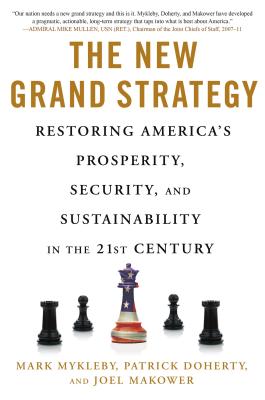How to achieve economic success in the 21st century
A new book suggests the U.S. must revive its strategic legacy
Kerby Meyers //July 14, 2016//


How to achieve economic success in the 21st century
A new book suggests the U.S. must revive its strategic legacy
Kerby Meyers //July 14, 2016//
 According to Mark Mykleby, Patrick Doherty and Joel Makower, the United States is stuck, an "analog country in a digital world,” reliant upon a system that “can’t keep pace with 21st century dynamics such as globalization, economic interdependence, climate change and violent extremism.”
According to Mark Mykleby, Patrick Doherty and Joel Makower, the United States is stuck, an "analog country in a digital world,” reliant upon a system that “can’t keep pace with 21st century dynamics such as globalization, economic interdependence, climate change and violent extremism.”
To escape this rut, the trio, authors of the recently released The New Grand Strategy, suggest a complete overhaul of the country’s economic engine—a rework rooted in sustainability. To clarify, that’s not sustainability singularly focused on environmental issues, but a concept that encompasses economic, security, social and environment concerns while ensuring that the U.S. economy remains diverse and productive over time.
The authors go on to offer richer definitions of diversity and productivity—thoughtful perspectives on otherwise potentially powerful words that have been genericized. Such deeper insights abound throughout the book, which is ultimately a methodical analysis of how this country, led primarily by the business world, can get its mojo back and re-establish itself as a global leader.
An economic restart after 50-plus years
The basis for the book is a 2009 treatise written by Mykleby, then a Marine colonel, and Wayne Porter, a Navy captain, as part of an assignment from Admiral Mike Mullen, the then-Chairman of the Joint Chiefs of Staff. The resulting A National Strategic Narrative stepped far beyond the military realm in addressing 21st century realities, but stopped short of policy suggestions, which they said should be handled by civilian leaders.
Over the next five years, Mykleby, who retired from the Marines in 2011, and Doherty crafted a strategy from the narrative and pitched it to the Obama administration and to Congressional leaders on Capitol Hill, but concluded that such a plan stood no chance in Washington’s toxic partisan environment. So they created the Strategic Innovation Lab at Case Western University in Cleveland and tapped Makower to join their team.
In this book, the trio explains that a broad U.S. strategy built on long-term goals and objectives isn’t a new idea, as such an initiative helped steer the country to success and prosperity through World War II and the Cold War. A commitment to national strategic thinking, however, was abandoned in 1961, and as a result, the country’s leaders still subscribe to a Cold War mindset, which the authors conclude is unsustainable.
To clear the cobwebs, the book proposes a new American growth scenario that capitalizes on:
- The rising demand and appeal of walkable communities
- A shift to regenerative agriculture from industrial agriculture
- The waste-trimming innovation inherent in heightened resource productivity

An opportunity for business
Given the ineptitude of elected officials to lead the U.S.—a state of being likely to continue no matter who prevails this November— Mykleby, Doherty and Makower place the responsibility to save the country squarely on the shoulders of Corporate America.
Don’t worry. They aren’t merely dropping the problem of the century in the laps of already over-exerted owners and managers. But starting with the three key drivers of future demand identified above, they’ve thought through business model conversions for 10 key sectors. For example, they envision a transportation sector that evolves from automakers selling vehicles to transportation companies providing mobility services.
Farfetched? Consider that’s exactly the transition that Ford CEO Mark Fields announced the automaker was pursuing at the 2015 Consumer Electronics Show.
As for the needed capital, the book points to the trillions of dollars of uninvested cash camped on the balance sheets of publicly held companies and in the coffers of hedge funds and private equity firms. Furthermore, the authors contend that creatively addressing so-called stranded assets, or raw materials, workers, capital equipment and real estate that stand to lose considerable value with broader economic shifts, can help spark needed industry conversions.
Certainly, some will dismiss this book as a different spin on a progressive agenda. For others, an underlying fear of change and aversion to risk will prompt wariness of its broad strategic mindset.
Yet, the pedigree of the authors and their non-partisan mindset is hard to dispute and their market-driven rationale bears consideration. Given the economic malaise of the country—and its uninspiring outlook—it’s going to take some bold, fresh action to make the U.S. vibrant again. And as with any enterprise, a solid strategic roadmap is essential to establish goals and objectives that fuel ambitious aspirations.
























